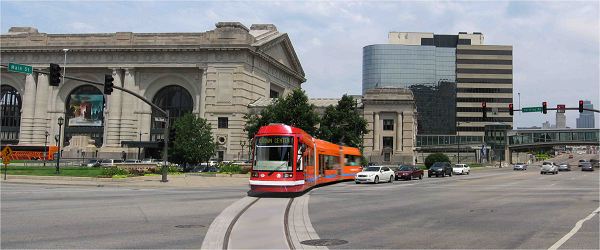Happening Now
With First Phase Under its Belt, DC Eyes Future Streetcar Expansion
June 26, 2014
Written By Maxime Devilliers

NARP policy intern Max Devilliers, a longtime resident of the Washington, DC-metropolitan area, attended an open house meeting on Washington's future North-South streetcar line on June 12.
Streetcars were once the lifeblood of the Nation’s Capital, much like many other U.S. cities. The last streetcar ride in D.C. on January 28, 1962 marked the end of an era.
The District Department of Transportation (DDOT) implemented a plan several years ago to bring streetcars back to the neighborhoods of Washington, D.C. Streetcar tracks have finally returned to H Street Northeast and Benning Road in the District, although residents continue to wait for the service to begin.
The Department has already begun conducting studies on a separate north-south route from the Takoma neighborhood to Buzzard Point and has held three separate series of public meetings to elicit comments and concerns from residents. I attended the last of the public meetings on June 12 and was intrigued by the responses from neighbors which I found to be unfortunately more cynical of the project than I had expected.
Many concerns with the project revolved around construction-related traffic congestion, noise, cost of the project, and diminished parking spaces, which was expected. However, neighbors were also concerned that such an expensive project might actually backfire and be ineffective in reducing traffic congestion. One neighbor even claimed that the streetcar is being built simply to appease those people that think they are “too good” for buses. Representatives from the companies being contracted by DDOT reassured the neighbors that the streetcar was necessary in resolving issues with both buses and traffic congestion along the corridor.
The buses that currently serve the proposed route often experience overcrowding, long boarding times, and “bus bunching,” which the representatives identified as problems with the current system. A concerned resident asked why the addition of more buses wouldn’t solve the problems that are being experienced along the route. One representative from the transportation planning firm, Kittelson & Associates, Inc., cited the increase in ridership followed by an increase in bus circulation as actually having caused the congestion problems. The delays and bus bunching can no longer be resolved with more buses but can be ameliorated with the addition of another mode of transportation. More and more city transportation departments are starting to understand this and are pushing for streetcar systems in their own downtowns.
The resurgence of streetcars in Washington is not a unique one. New streetcar projects are underway in cities across the United States such as Cincinnati, Kansas City, and Seattle. Long-distance light rail projects are also making great headway in the United States such as the MAX line being built to Milwaukie from Portland, Oregon and the METRO Green Line that began service on June 14th in the Twin Cities region. Each of these projects are expected to be very successful in their respective cities. The District Department of Transportation expects initial ridership on the new 8.5-mile North-South line to reach somewhere between 11,000 and 16,000 daily. The Twin Cities’ 10.5-mile METRO Green Line attracted 45,000 riders in its first eight hours of operations this past weekend. Total benefits of the Cincinnati streetcar are expected to exceed $430.9 million in economic development for their region.
What’s exciting about these projects is that they connect, or will eventually connect, to the main train stations in their respective cities. This enables citizens to travel between and within cities without cars. With more fixed-route public transit like streetcars and light rail returning to America, which tend to be easier to understand than city bus systems, travelers are finding fewer and fewer reasons to make trips by car as riding public transit becomes more convenient and available.
In the United States, a concern of traveling by intercity train is either the difficulty or exorbitant cost of getting around after arriving to a destination. With streetcars connecting train stations to downtowns and other neighborhoods, people of all ages and economic backgrounds will be able travel by train without the worry of paying for a taxi, renting a car, or figuring out how to utilize local buses. Furthermore, as people continue to choose living car-free, they need more options for getting around efficiently, quickly, and cost-effectively. According to data from DCStreetcar.com, 24% of households along the proposed north-south route do not own private vehicles and rely on other modes of transportation.
I hope that the information given to the neighbors was sufficient in reassuring them that this project is necessary and will be quite beneficial for everyone. The skepticism toward streetcars in D.C. is based uponthe delays that have been experienced on the H Street line. However, the representatives at the meeting claimed that the planning process will be much improved the second time around. We, here at NARP believe that streetcar projects will continue to come to fruition in cities across the U.S. so as to connect people with trains and keep our country moving easily, safely, and efficiently.
"On behalf of Amtrak’s onboard service staff, I want to thank the Rail Passengers Association for honoring their hard work with this award. The past couple years have indeed been difficult for Amtrak onboard service staff – coping with furloughs and job insecurity, adapting to changing protocols and services, not to mention the unfortunate events such as a tragic derailment and a fatal shooting. Nevertheless, our dedicated members at Amtrak have handled these hurdles with the care, attention and diligence for which they’re known. We thank Rail Passengers for their acknowledgement of our members’ hard work and, as always, look forward to seeing you on the rails."
Arthur Maratea, TCU/IAM National President
December 21, 2021, on the Association awarding its 2021 Golden Spike Award to the Frontline Amtrak Employees.
Comments